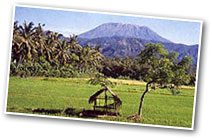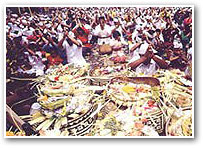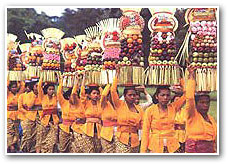|
 Bali, an island
streaming with holy water. Sacred lakes and mountain springs
shed life-giving water in all directions through narrow, deep
river gorges into fertile plains. For over a thousand years,
the Balinese have practiced an unique and ingenious system of
irrigation called "Subak" and terracing that has allowed them
to grow an abundance of rice and support an unusually dense
population, and this in turn has given rise to a culture of
extraordinary richness and intensity. Most of the rice is
grown on the broad plains that descend gently toward the
south. On the steep northern slopes facing the Java Sea are
large plantations of coffee and cloves. Although life is much
harsher in the arid lands of northeast and northwest Bali,
most families have at least enough land to grow vegetables and
fruits for their own use and to keep ducks, chickens, two or
three pigs, and sometimes cow for ploughing, or an calf to
fatten the market. Bali, an island
streaming with holy water. Sacred lakes and mountain springs
shed life-giving water in all directions through narrow, deep
river gorges into fertile plains. For over a thousand years,
the Balinese have practiced an unique and ingenious system of
irrigation called "Subak" and terracing that has allowed them
to grow an abundance of rice and support an unusually dense
population, and this in turn has given rise to a culture of
extraordinary richness and intensity. Most of the rice is
grown on the broad plains that descend gently toward the
south. On the steep northern slopes facing the Java Sea are
large plantations of coffee and cloves. Although life is much
harsher in the arid lands of northeast and northwest Bali,
most families have at least enough land to grow vegetables and
fruits for their own use and to keep ducks, chickens, two or
three pigs, and sometimes cow for ploughing, or an calf to
fatten the market.
Bali's fame is disproportionate to its size. The island is
about 5,600 square kilometers in a nation covering over five
million square kilometers. Hindu Bali is the one of 27
provinces of the Republic of Indonesia, the largest Muslim
country on earth. Although Indonesia comprises over three
hundred ethnic groups and over three thousand populated
islands, Bali is the only province that is also at once an
island and an ethnic group, and this gives the Balinese a
heightened sense of their distinctiveness as they try to find
their identity as modern Indonesians. Meanwhile, behind
handsome courtyard walls of soft stone, an archaic,
spirit-smitten way of life continues.
Bali is society of hamlets clustered around temples. Bali
as a culture organism, the villages are its vital organs, and
the network of temples its nervous system. The Balinese have a
highly detailed religious culture that an order influence and
integrates almost every aspect of their life from birth to
death, including such aspects as agriculture, architecture and
village law.
 Balinese
Hinduism is vibrant and syncretic. At its most ancient core is
animism, bound with threads of tantric Buddhism and ancestor
veneration that probably originated in southern China.
Numerous Hindu sects found their way to Bali through
migrations from classical Hindu Java in the first millenium,
bringing the Indian epics, the Ramayana and
Mahabharata. Balinese
Hinduism is vibrant and syncretic. At its most ancient core is
animism, bound with threads of tantric Buddhism and ancestor
veneration that probably originated in southern China.
Numerous Hindu sects found their way to Bali through
migrations from classical Hindu Java in the first millenium,
bringing the Indian epics, the Ramayana and
Mahabharata.
According to Nagarakertagama, an east Javanese
chronicle, in the 14th Century Bali was conquered
by the Hindu Javanese kingdom of Majapahit, infusing the
island with its elegant arts and court culture. When the
empire began to collapse in the 16th century, the
Javanese priestly aristocracy took refuse in Bali, fleeing the
advance of Islam, and Balinese Hinduism underwent a renewal
under the inspiration of the priest-poet Dhanghyang
Nirartha, also known as Pedanda Sakti Wawu Rauh
( "the newly arrived and powerful high priest" ). Nirartha
traveled all over Bali, teaching and establishing many
temples. The most famous of these is Tanah Lot.
The Balinese sum up their view of life in three fundamental
relationships (also known as Tri Hita Karana): to the
spiritual world, to the world of human beings and to the
natural world around them. They also believe that these worlds
interpenetrated each other, and that it is the responsibility
of human being to make sure that this interaction is balanced
and harmonious. The Balinese accomplish this through ritual,
expressed in the form of religious offerings.
 Offerings are
composed of food, flowers and confections of fresh palm
leaves, cut and pinned in abstract figures, and are offered
with incense, spring water, flowers and mantra. The Balinese
classify their ritual in five sorts (Panca Yadnya):
those for gods, for the spirit of dead body, for the
initiation of priests, for the rites passage in the growth of
human beings, and for the demons. A complex calendrical system
orders the timing of rituals. Offerings are
composed of food, flowers and confections of fresh palm
leaves, cut and pinned in abstract figures, and are offered
with incense, spring water, flowers and mantra. The Balinese
classify their ritual in five sorts (Panca Yadnya):
those for gods, for the spirit of dead body, for the
initiation of priests, for the rites passage in the growth of
human beings, and for the demons. A complex calendrical system
orders the timing of rituals.
Although individual mystic practices exist in Bali,
religious devotion is generally a communal affair, and this is
the basis of the great cohesiveness of Balinese village life.
Every Balinese village has several temples to which all the
villagers belong, and in a certain sense a village can be
defined as the congregation of a group of temples. Because of
this communal responsibility for the care of the gods, a
village must maintain its spiritual purity. A strict code of
customary law governs the lives of villages to a remarkable
degree.
The temples themselves are spaces of holy ground surrounded
by walls, with a number of small pavilions for the particular
deities to whom the temples are dedicated. Balinese Hinduism
has always acknowledged one Supreme Being by various names:
the gods are manifestations of the ultimate omnipotent,
unknowable God - spirituals energies of nature and deified
kings and ancestors - and they are honored with splendid
festivals on the temples anniversary.
|


